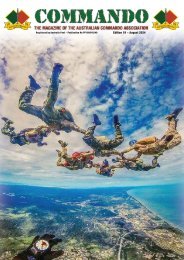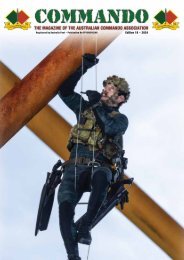Commando News Magazine edition 8 2021
Create successful ePaper yourself
Turn your PDF publications into a flip-book with our unique Google optimized e-Paper software.
As if this wasn't enough, Shanghai was also haunted<br />
by increased Chinese nationalist activity, an increasing<br />
amount of armed robberies. Terrorist kidnappings &<br />
bombings and rioting and large-scale conflict was also<br />
very common. The Green Gang was often hired by<br />
Chinese Chiang Kai-shek's Kuomintang for political<br />
violence and they, along with other criminal gangs took<br />
part in the White Terror massacre where some 5,000<br />
pro-communist strikers in Shanghai were slaughtered<br />
in April 1927.<br />
It was a huge boiling pot of vicious violence and<br />
Fairbarn was right in the middle of it at quite young<br />
age, something which would shape the rest of his life,<br />
laying the foundation of a very pragmatic and ruthless<br />
perspective on violence and martial arts.<br />
Sikh, Chinese and British members of the SMP<br />
Later, after the war,<br />
Fairbairn would create and<br />
train a special anti-riot<br />
squad for the SMP and<br />
many of the tactics and<br />
techniques developed<br />
here are still in use today.<br />
It is here, in 1919 in<br />
Shanghai, that he met Eric<br />
A. Sykes, while Sykes was<br />
still working with weapons<br />
import/export at a British<br />
Secret Service-run com -<br />
pany. Sykes was an expert<br />
Eric A. Sykes marksman and came to<br />
form and oversee a team of civilian & police snipers for<br />
the SMP and naturally he also became the head of this<br />
unit in 1937. In 1939 Sykes would properly join the<br />
British Secret Intelligence Service (SIS-MI6).<br />
Based on their experiences and training the two<br />
designed their own martial arts system for specific use<br />
for the Shanghai Municipal Police called Defendu. For<br />
hand-to-hand combat Fairbairn mixed Savate, Jujitsu,<br />
early Judo, Chinese martial arts (he had studied Kung-<br />
Fu with the Empress' former bodyguard), wrestling and<br />
boxing, all of it reflected against his own experience of<br />
raw and brutal street fighting as a police.<br />
The system emphasized pragmatical rather than<br />
gentlemanly and honourable fighting, teaching rapid<br />
disabling of the opponent with potentially lethal force.<br />
Fairbairn declared:<br />
Get tough, get down in the gutter, win at all costs...<br />
I teach what is called ‘Gutter Fighting.’ There’s no fair<br />
play, no rules except one: kill or be killed.<br />
The techniques of the system were brutal and quick,<br />
which can be examplified by the following quote from<br />
the SOE syllabus:<br />
The Queensberry rules enumerate, under the<br />
heading of 'fouls', some good targets which the boxer<br />
is not trained to defend. This, however, is WAR, not<br />
sport. Your aim is to kill your opponent as quickly as<br />
possible. ... So forget the Queensberry rules; forget the<br />
term 'foul methods'. That may sound cruel, but it is still<br />
more cruel to take longer than necessary to kill your<br />
opponent. 'Foul methods', so-called, help you to kill<br />
more quickly... Don't just stop because an opponent is<br />
crippled. If you have broken his arm, for instance, that<br />
is only of value because it is then easier to kill.<br />
During his 30 years of service in Shanghai Fairbairn<br />
reportedly engaged in at least 600 actual fights. Large<br />
parts of his body, with arms, legs, torso and even the<br />
palms of his hands are said to have been covered with<br />
scars from knife wounds sustained during those years.<br />
The Defendu system was designed to be easy to<br />
learn and to provide effective results. It included<br />
unarmed fighting as well as gun combat & point<br />
shooting, use of knives, clubs and improvised weapons<br />
such as chairs or table legs. As such it fulfilled the<br />
needs of the military quite well too. Consequently,<br />
Fairbairn's and Sykes' teachings were adopted by the<br />
Allies in 1941 and first taught at the British <strong>Commando</strong><br />
School in Scotland, although in a militarized form<br />
called British Close Quarters Combat. Much of<br />
Fairnbairn's and Sykes' pioneering work in close<br />
combat, riot control, clandestine operations and<br />
trained instinctive fighting with guns and knives is still<br />
in use by military and police around the world today.<br />
The Fairbairn-Sykes Fighting Knife<br />
Already in Shanghai Fairbairn was working on<br />
designing a combat knife for their martial arts system,<br />
together with Sykes and a young US Marines officer;<br />
2nd Lt. Samuel Sylvester Yeaton.<br />
A rare believed genuine Shanghai Knife, designed to be<br />
carried hanging upside-down and used by the SMP.<br />
Photo courtesy of Gota Vapen<br />
The work continued back in England in November<br />
1940, then with the less commonly known, Col. Leslie<br />
Wood R.E and Jack Wilkinson Latham of manufacturer<br />
Wilkinson Sword Ltd. And this is the actual birth of the<br />
now quite iconic knife, the British commando knife,<br />
commonly called the Fairbairn-Sykes.<br />
F–S fighting knife blueprint from FMFRP 12-80, Kill<br />
or Get Killed, by Rex Applegate. Image from Wikipedia<br />
COMMANDO ~ The <strong>Magazine</strong> of the Australian <strong>Commando</strong> Association ~ Edition 8 I <strong>2021</strong> 43
















